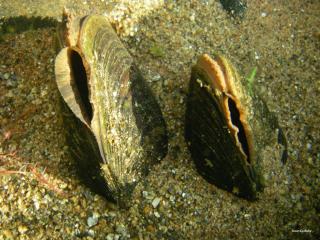The Impacts of River Engineering on the Freshwater Pearl Mussel in Scotland
Published on 18 February 2011 in Ecosystems and biodiversity

Introduction
Scotland is a European stronghold for the critically endangered freshwater pearl mussel Margaritifera margaritifera, holding around half of the world's known breeding populations. Policy measures to support the conservation of the species in Scotland include the designation of 21 Special Areas of Conservation (SACs) and Sites of Special Scientific Interest (SSSIs) (jncc.gov.uk), implementation of a Species Action Plan, and targeted management action under Scotland’s Species Action Framework. The freshwater pearl mussel and its habitat are fully protected by the Wildlife and Countryside Act 1981 (as amended) and the species is a UK wildlife crime priority.
The main threats to the freshwater pearl mussel in Scotland are: damage to habitat, a decline in salmon and trout (on which the species depends as hosts for its larvae), poor water quality (especially nutrient enrichment and siltation), plantation forestry (which can increase siltation and degrade habitat), and pearl fishing. Damage to habitat is often caused by river engineering activities (e.g. pipe-laying operations, hydro-power generation schemes, embanking, canalisation, channel realignment, cattle fords, bridge supports and fishery management works). Such activities have had serious impacts on freshwater pearl mussel populations worldwide. Damage to habitat is one of the principal illegal problems affecting the species in Scotland, where river engineering has been directly implicated in the decline of at least 26 populations (Cosgrove et al., 2000; Langan et al., 2007).
Key Points
- An analysis of 18 of the sites that have been designated for the freshwater pearl mussel has described the range of environmental pressures at each one and recommended the most beneficial and urgent management prescriptions. River engineering remains a threat in at least 10 of the 21 sites.
- A statistical analysis of the River Dee freshwater pearl mussel population showed that some river engineering features are associated with its distribution at a catchment scale. The persistent impacts of river engineering may be linked to the population’s unfavourable status.
- Field studies of the two designated sites that are regulated by hydro electric power schemes recorded the environmental impacts of impoundment and flow regulation. Overall, the condition of the rivers is not severely degraded, but their geomorphology has changed measurably. Further research is needed to establish whether changes in the mussel populations are linked to the regulation of these rivers.
- Interviews with river engineers revealed that none had a full understanding of the threats posed by their activities, although the majority recognised that these have the potential to harm freshwater pearl mussels in some way. Few respondents were aware of available guidelines, and the majority expressed a need for additional information. Scottish Natural Heritage (SNH) has since produced and promoted a new guidance leaflet.
Research Undertaken
Scottish Natural Heritage, the Macaulay Land Use Research Institute and Biomathematics and Statistics Scotland are working together to better understand the impacts of river engineering on freshwater pearl mussel populations in Scotland. A range of projects relating to the prevalence, impacts and awareness of river engineering at sites designated for the freshwater pearl mussel were undertaken. The research was funded by SNH and the Scottish Government’s Environment Programme on Landscape and Rural Stewardship (Programme 3).
- Threats to pearl mussel populations were analysed at 18 designated sites by collating and interpreting environmental data and the results of interviews with local stakeholders, (Langan et al., 2007).
- Impacts of river engineering were assessed using statistical methods and field studies at selected sites. At one site, relationships between the distribution of freshwater pearl mussels and morphological features were explored using a range of statistical techniques (Cooksley et al., 2010b). Populations and fluvial geomorphology in two rivers impacted by hydro electric power generation were also studied (Cooksley et al., 2010a; Cooksley et al., 2009).
- Thirty-two contractors who undertake river engineering activities were interviewed to determine their levels of awareness of freshwater pearl mussels, the threats to them, and the law that protects them. Respondents represented the full range of river-related civil engineering activity, including drainage facilitation, abstraction, flood prevention and infrastructure-related work (Booth et al., 2009).
Policy Implications
- Both the UK and Scottish Governments have obligations for the conservation of the freshwater pearl mussel as an Annex 2 species of the EC Habitats Directive.
- The status of the populations at designated sites is well-described, but there is a need to better understand the environmental pressures specific to these river catchments.
- River engineering features can be associated with freshwater pearl mussel distribution at a catchment scale. Conservation agencies and river managers should therefore consider how past and existing works have affected populations. Where there is an opportunity to address ongoing morphological impacts, our results support the consideration of a monitored restoration project.
- Studies of two regulated rivers have provided a baseline for future work that will investigate physical controls on the pearl mussel populations and be used to improve management strategies in these catchments.
- There is a need to encourage wider dissemination and adoption of best practice guidance for river engineering.
- The above studies are part of ongoing research that is continuing under the Scottish Government’s research programme 2011-2015.
Author
Dr Susan Cooksley s.cooksley@macaulay.ac.uk





